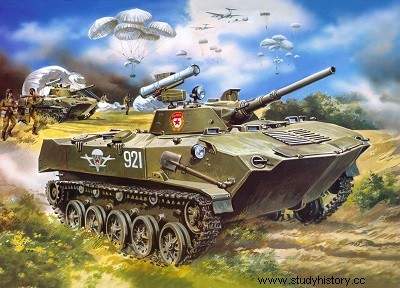
Type: light support tank.
Crew :3 + 6 men.
Armament :a 76 mm gun; a coaxial 7.62mm PKT machine gun; one 7.62 mm PKT machine gun on each side of the hull; a launch pad for the ATGW "Sagger" anti-tank missile.
Armour :information not received.
Dimensions:
length :5.30 m;
width :2.65 m;
height: 1.85 m.
Weight in combat order: 9t
Performance:
road speed speed:55 km/h;
speed on water: 6 km/h;
vertical obstacle :0.60 m;
clean cut: 2 m;
slope :60%.
Service time :introduced into the Soviet army in 1971-72
The BMD (or M1970, as it was originally called) made its first official release in November 1973, wearing the insignia of a Soviet airborne unit. It is a new vehicle, derived from no other, although its turret is identical to that of the BMP-1 motorized infantry fighting vehicle. It is believed that the role of the BMD ("Boyevaya Mashina Desantnaya") is twofold:on the one hand to provide the Soviet airborne units with the mobile artillery support which they lacked until then and, on the other hand, to act as a carrier of troop, allowing airborne units to attack targets relatively far from their landing point. So far; the only armor used by the Soviet airborne troops were the ASU57 and ASU-85 self-propelled anti-tank guns. It is very likely that the BMD will also be the successor to the PT-76 amphibious light tank that has been in service for more than 20 years. The BMD can be airborne and parachuted.
The hull is a fully wrought assembly, but it is unknown whether it is steel or aluminum. The driver is in the front center; the turret is behind him and the troop compartment behind it. The suspension has five road wheels, the tension wheel at the front and the sprocket at the rear; there are two support rollers. The 73 mm gun is fed by a magazine containing approximately 28 shells. It offers a shot in elevation of +20° to -5° and, in azimuth of 360°. A 7.62mm PKT machine gun is paired with it. A shell; both of these guns are thought to be served by the driver. A launch pad for the ATGW "Sagger" anti-tank missile is mounted on the barrel.
Totally amphibious, the MBD is propelled on water by two hydro-reactors located at the rear; before entering the water, an anti-wave blade stands at the front of the hull. The BMD has night vision equipment and most likely an NBC system. The crew consists of three men:commander gunner and driver. The BMDs seen in Moscow carried six infantry, seated in two rows of three in the rear troop compartment. Apparently the rear of the hull does not offer sufficient interior space to accommodate the six men in addition to the engine and transmission. However, it seems that the infantrymen have the possibility of moving towards the front part of the hull, because its sides are provided with episcopes. In addition, one can notice the presence of a hatch on each side, behind the driver's position. Nothing is planned to allow infantrymen to use their weapons from inside the hull. By its size and weight, the BMD is a truly unique vehicle, which cannot be compared to any other in the whole world.
